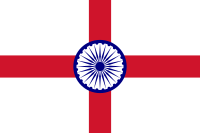Sardarilal Mathradas Nanda
Admiral Sardarilal Mathradas Nanda, PVSM, AVSM (10 October 1915 – 11 May 2009) was an Indian Navy Admiral who served as the 8th Chief of the Naval Staff from 1 March 1970 until 28 February 1973.[1] He led the Indian Navy during the Indo-Pakistani War of 1971 and successfully executed a naval blockade of both West and East Pakistan, helping India achieve an overwhelming victory during the war.[2] He is one of the most notable commanders in the history of the Indian Navy.
S M Nanda | |
|---|---|
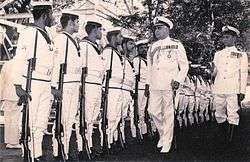 Admiral Nanda reviewing an honour guard at INS Adyar in 1972 | |
| Nickname(s) | Charles |
| Born | 10 October 1915 Punjab, British India |
| Died | 11 May 2009 (aged 93) New Delhi, India |
| Allegiance | |
| Service/ | |
| Years of service | 1941–1973 |
| Rank | |
| Commands held |
|
| Battles/wars |
|
| Awards | Padma Vibhushan Param Vishisht Seva Medal Ati Vishisht Seva Medal |
| Other work | Chairman and Managing Director Shipping Corporation of India Member of the Board of Directors, Crown Corporation |
Early life and education
Nanda was born on 10 October 1915 to Mathra Das, an office superintendent at the workshop of the Port Trust in Manora, and Pooran Devi. His parents were from villages near Gujranwala in the Punjab Province.[3] He was raised on Manora Island at the entrance to the Port of Karachi.[1][4] He was the eldest of seven children - three boys and four girls. He attended a primary school on the island and then the N J High School in Karachi. He worked for the Port and Pilotage department at Manora after finishing his schooling.[3]
After the outbreak of World War II, he applied for a commission in the Royal Indian Naval Volunteer Reserve (RINVR). He appeared before a selection board in Bombay in September 1941. Successful in the written test and the interview, he was commissioned in the RINVR on 11 October 1941 as an acting Sub-lieutenant in the Executive Branch.[5]
Naval career
Nanda started his career with a training course for six months on the Deepawati. He was then sent to Calcutta for his next assignment. At Calcutta, he was asked to go to Khulna and take command of a river steamer and patrol the Sundarbans. In June 1942, he was selected for a specialist communications course at the HMIS Talwar, the Signals School in Colaba, Bombay. After the course, he served as the Signals Officer on-board the minesweeper HMIS Travancore.[6] In October 1942, he was promoted to the acting rank of Lieutenant and appointed as an instructor at the Signals School. after the end of the war, he stayed in the Navy despite rapid, large-scale demobilisation. He appeared before a selection board in Lonavala on 31 October 1945.
Nanda was serving at the Signals School at HMIS Talwar when the Royal Indian Navy mutiny broke out in February 1946. The mutiny first started at HMIS Talwar and spread to ships and other shore establishments.[8] The mutiny was called off after the sailors met with Sardar Vallabhbhai Patel. He was asked by the sailors to accompany them, which he did.[9]
In June 1946, he was posted to the sloop HMIS Narbada (U40) which was to sail for Japan from Madras. The ship was based out of Kure, Hiroshima as part of the British occupation forces and was later transferred to Sasebo, Nagasaki as part of the US occupation forces. On 19 October 1946, he was granted a permanent commission in the Royal Indian Navy (RIN) as a Lieutenant with backdated seniority of 10 October 1940.[10] In January 1947, he was appointed Communications Officer of the sloop HMIS Cauvery (U10), then deployed at Karachi.
Post-Independence
After the partition of India, the Cauvery was assigned to India and she set sail for Bombay. The British officers embarked for England and Nanda was appointed Executive Officer of the ship. HMIS Kistna (U46) and Cauvery commanded by Commander Ram Dass Katari and Commander Reggie Sawhney respectively made two trips to the United Kingdom. This was because the cruiser HMS Achilles (70) was being purchased by India and renamed HMIS Delhi and the crew was to be transported.[11] In 1948, he was promoted to the acting rank of Lieutenant Commander and appointed first lieutenant of HMIS Delhi (1948) under the command of Captain H.N.S. Brown, with Commander Ram Dass Katari as his executive officer.[1] To train for this appointment, he was ordered to join the Mediterranean Fleet. He served on board the aircraft carrier HMS Triumph (R16) and subsequently on the cruiser HMS Newcastle (C76).[12]
HMIS Delhi was commissioned on 5 July 1948 by the High Commissioner of India to the United Kingdom V. K. Krishna Menon. On her way to India, she called at Portsmouth, Portland, Gibraltar and Malta. The Prime Minister of India Jawaharlal Nehru himself welcomed the ship at Bombay.[13] She went on a cruise round the coasts of India, calling at Karwar, Cochin, Trincomalee, Madras, Vizag, Calcutta, Port Blair, Colombo and Calicut before returning to Bombay.[14] In May 1949, she left on her Indian Ocean cruise. She called at Victoria, Seychelles, Port Louis in Mauritius, Dar es Salaam in Tanzania and Mombasa in Kenya. The cruise to the Indian Ocean republics and East Africa generated a tremendous amount of goodwill.[15][16]
On 30 June 1949, at the end of the goodwill mission, Nanda was promoted substantive lieutenant-commander and to the acting rank of Commander.[17] He was appointed director of personnel services (DPS) at Naval headquarters.[18] Nanda was promoted to substantive commander on 31 December 1950.[19] He served as the DPS for about two years. On 10 October 1951, he took command of the R class destroyer, INS Ranjit (1949).[20] The Ranjit was part of the 11th Destroyer Squadron commanded by Captain Ram Dass Katari. The other two ships in the squadron were INS Rajput (D141) and INS Rana (1942).[21] Nanda took the ship on a goodwill cruise to Singapore, Saigon, Jakarta and other ports in Indonesia like Bali. In Jakarta, he called on and was received by the first President of Indonesia, Sukarno.[22]
In early 1952, Princess Elizabeth and Prince Philip, Duke of Edinburgh set out for a tour of Australia and New Zealand by way of Kenya. The Rajput and the Ranjit were nominated to escort the HMY Britannia from Mombasa to Australia.[23] With the death of King George VI, this was cancelled. To commemorate the Coronation of Elizabeth II, a massive Coronation review of the fleet was held at Portsmouth. The flagship INS Delhi, destroyer INS Ranjit and frigate INS Tir (K256) represented India at the review. A naval armada consisting of ships from the Indian Navy, Royal Navy, Royal Australian Navy and the Royal New Zealand Navy sailed from Portsmouth to Gibraltar. The fleet carried out exercises along the way and was under the command of Lord Mountbatten. The Ranjit under Nanda acquitted itself well during these exercises. Subsequently, the Indian ships continued conducting exercises with the Mediterranean Fleet. They sailed from Gibraltar to Malta, the Greek islands and to Istanbul.[24]
Nanda took command of INS Jamuna (U21) on 31 August 1953 after returning to Bombay. He was also appointed Captain (F) 12th Frigate Squadron. On 15 February 1954, he was promoted to the acting rank of Captain and appointed CAPBRAX (captain naval barracks) and Commanding Officer of INS Angre. After a short stint, he was transferred back to Naval Headquarters as Chief of Personnel (COP) in September 1954. He was promoted to substantive captain on 31 December 1954.[25] He served as the COP for about two and a half years. In September 1956, he was promoted to Commodore 2nd Class.[26]
In December 1956, he was appointed the commissioning commanding officer of INS Mysore (1957). The Crown Colony-class cruiser HMS Nigeria (60) was being refitted and modernised in Birkenhead, Liverpool to be commissioned as the Mysore. He spent a few months in UK preparing his crew. INS Mysore was commissioned on 29 August 1957 by the High Commissioner of India to the United Kingdom Vijaya Lakshmi Pandit. Nanda took the ship to the Mediterranean and subsequently paid an official visit to the port of Split in Socialist Federal Republic of Yugoslavia. He called on President Josip Broz Tito at his home in the Brioni Islands.
Returning to India, Nanda and the Mysore were welcomed by the entire Indian Fleet, commanded by the first Indian Fleet Commander Rear Admiral Ram Dass Katari. Katari's flag was transferred from INS Delhi to INS Mysore, thus becoming the new flagship of the Indian Fleet.[27] The Prime Minister Jawaharlal Nehru visited the ship at Bombay and hosted a dinner on board with the Governor of MaharashtraAli Yavar Jung, the Minister of Defence V. K. Krishna Menon, Chief Minister of Maharashtra Vasantrao Naik being present.[28] After visiting the ports in India, Nanda took the ship to a goodwill visit to China and Japan in the summer of 1958. She called at Singapore, Hong Kong, Shanghai and Yokohama. On the return passage, she called at Haiphong. Before leaving India for the goodwill visit, Nanda had been selected to attend the Imperial Defence College (IDC) and was to embark for the UK after completing the visit. Instead he was informed after departing from Haiphong that his deputation to IDC stood cancelled.[29]
Personally selected by the Defence Minister V K Krishna Menon, Nanda took over as the Director General Naval Dockyard Expansion Scheme (DG-NDES) on 1 October 1958. He undertook a major expansion of the dockyard.[30] He extended the dimensions of the cruiser dock to accommodate the aircraft carrier HMS Hermes (R12) being acquired from the UK. This resulted in tremendous advantage for the Indian Navy. For distinguished service during his tenure as DG-NDES, Nanda was awarded the Ati Vishisht Seva Medal in 1961.[31] In June 1960, he was appointed Officer on Special Duty (OSD) at Naval HQ.[32] Nanda was selected to attend the Imperial Defence College and embarked for the UK in early 1961. After completing the year-long course, he returned to India and was appointed Chief of Material (COM) in February 1962.[33]
Flag Rank
In May 1962, Nanda was promoted to the acting rank of Rear Admiral and appointed Deputy Chief of Naval Staff.[34][35] As DCNS, he was instrumental in obtaining permission and clearance from the Government of India (GOI) for the naval development of the port at Goa, which was recently annexed. Given the difficulty India had in negotiating the purchase of INS Vikrant (R11) from the UK, Nanda supported the acquisition of equipment from the Soviet Union. Promoted to substantive rear-admiral on 16 June 1964,[36] Nanda was appointed Managing Director of Mazagon Dock Limited in December 1964. He undertook preparations for the construction of Nilgiri class frigates, the first major naval vessels to be constructed in India. After a 18-month tenure, he handed over charge to Rear Adm Benjamin Abraham Samson in May 1966. Shortly afterwards, in October, the keel of the first frigate INS Nilgiri (F33) was laid.[37] For his distinguished service as MD of Mazagon Dock, he was awarded the Param Vishisht Seva Medal in January 1966.[38]
On 1 June 1966, Nanda took command of the Indian Fleet as the Flag Officer Commanding Indian Fleet at Bombay.[39] Flying his flag, the fleet visited the Persian Gulf in April 1967. The INS Vikrant (R11) visited Bahrain and Kuwait, while her escorts INS Trishul (F143) and INS Talwar (F140) visited Abadan and Basra. The fleet tanker INS Deepak joined the fleet under Nanda.[40]
Nanda took over as Flag Officer Bombay (FOB) on 1 February 1968. In March 1968, the reorganisation of the Navy took place. Posts were upgraded and created at the Naval HQ as well as the naval commands. Nanda was promoted to the rank of Vice Admiral and became the first Flag Officer Commanding-in-Chief (FOC-in-C) Western Naval Command.[41][42][43] Nanda organised the Navy Week in December 1969 which culminated with the review of the Indian Naval Fleet by President V. V. Giri. A successful event, it raised the navy's profile in Bombay. The Navy Week involved the businessmen, industrialists, bollywood stars and the society at large. Funds were raised and a Sailors' home and an Officers' Mess was also built.[44]
Chief of Naval Staff
In November 1969, the GOI decided to appoint Nanda as the next CNS in succession to Adm Adhar Kumar Chatterji.[45] On 1 March 1970, Nanda took command as the 8th Chief of the Naval Staff of the Indian Navy.[46] The 1962 Sino-Indian War was largely fought over the Himalayas and the Navy did not have a major role. During the Indo-Pakistani War of 1965, the Navy was ordered to stay within Indian waters. When the Pakistan Navy bombarded Dwarka, Nanda recognised the need to raise the Navy's profile and capabilities. He was determined to change the mindset of the service from defence to attack.[47] He got the opportunity to demonstrate this capability the following year during the war with Pakistan.
Indo-Pakistani War of 1971
The Indo-Pakistani War of 1971 was sparked by the Bangladesh Liberation war, a conflict between the traditionally dominant West Pakistanis and the majority East Pakistanis. In 1970, East Pakistanis demanded autonomy for the state, but the Pakistani government failed to satisfy these demands and, in early 1971, a demand for secession took root in East Pakistan. In March, the Pakistan Armed Forces launched a fierce campaign to curb the secessionists, the latter including soldiers and police from East Pakistan. Thousands of East Pakistanis died, and nearly ten million refugees fled to West Bengal, an adjacent Indian state. In April, India decided to assist in the formation of the new nation of Bangladesh.[48]
Nanda was instrumental in framing India's Naval strategy during the war. He feigned a defensive deployment southeast towards the Andaman Islands, instead moving his Eastern fleet northwards into the Bay of Bengal and enforcing a naval blockade against East Pakistan.
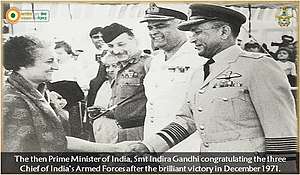
His strategy against West Pakistan was to strike hard against Pakistan's main port of Karachi.[1] He is recognized as the mastermind behind Operation Trident and Operation Python.[49] The plan for the operations included towing the limited-range Vidyut class missile boats, primarily designed for coastal defence, to about 250 nautical miles (460 km) south of Karachi during the day, out of range of the Pakistan Air Force aircraft.[50] The missile boats then closed in on Karachi port at night and attacked naval targets as well as the oil tank farm at Keamari. Operation Trident was successfully executed on 4 December 1971, sinking the Pakistan Navy destroyer PNS Khaibar, minesweeper PNS Muhafiz, an ammunition carrying ship MV Venus Challenger and irreparably damaging another destroyer PNS Shah Jahan as well as destroying numerous oil storage tanks. Operation Python was again successfully carried out on 8 December 1971.
On the Eastern front, Nanda made the decision to deploy the aircraft carrier INS Vikrant into the shallower waters of the Gulf of Bengal off Dhaka, to prevent the risk of a submarine attack. When concerns were raised about Vikrant's boilers being cracked, he took personal responsibility for the risk of a boiler explosion and catapult failure on the carrier. His gambit paid off, as Vikrant was able to successfully enforce the blockade of East Pakistan without any such damage to the carrier.
The war lasted less than a fortnight and saw more than 90,000 Pakistani soldiers taken prisoner. It ended with the unconditional surrender of Pakistan's eastern half and resulted in the birth of Bangladesh as a new nation.[51] In addition to the POWs, Pakistan suffered 6,000 casualties against India's 2,000.[52] The success of the naval blockades on two fronts is considered one of the primary factors in India's overwhelming victory during the war. For his services to the nation, he was awarded the Padma Vibhushan in January 1972.[1][53][54]
Post-retirement
Nanda retired from the Indian Navy on 30 August 1973.[55] He was appointed Chairman and Managing Director (CMD) of the largest shipping company in India, the Shipping Corporation of India (SCI) in May 1974.[56]
Personal life
At the age of 21, Nanda was married to Sumitra, a lady chosen by his parents. The marriage was harmonious and lasted all their lives, during which they were fated to suffer many vicissitudes together, ranging from the partition of India which uprooted them from their native land, to the heights of honour when Nanda became chief of the Indian Navy. The couple were the parents of several children, including a son, Suresh Nanda (ex-naval officer and businessman) and Beena Mehra, wife of Major Pradeep Kumar Mehra, founder of Usha Stud Farm on the outskirts of Delhi.
Nanda had to suffer personal tragedy when his daughter Beena, who was married to Major Pradeep Kumar Mehra, an army officer and polo enthusiast who founded and ran Usha Stud Farm on the outskirts of Delhi. The couple were the parents of three grown-up daughters. On 2 January 2002, Beena Mehra, her husband P.K. Mehra and their daughter Radhika were all killed in a helicopter crash while flying from Mussourie to Dehradun Airport after attending a New Year's Day party. Their other two daughters, Ameeta and Devika, survived since they was not on the helicopter; Ameeta Mehra now runs Usha Stud Farm.[57]
Controversies
Following his retirement, Nanda took an executive role with Crown Corporation, an arms trading firm headed by his son Suresh Nanda, which specialized in supply of imported weapons to the Indian Armed Forces.[58] The organization was surrounded by a controversy when Operation West End a sting-operation which aimed to expose corruption between India's defence ministry and Crown Corporation. The allegation on Admiral Nanda's son, Suresh Nanda, was closed by CBI when no evidence was found.[59]
Another incident that caused turmoil in the family was the 1999 Delhi hit-and-run case, which involved Admiral Nanda's grandson Sanjeev Nanda. Sanjeev Nanda was found guilty by the Supreme Court of India.[60] The accident and the trial attracted a lot of media attention and became one of the cases that exemplified middle class India's frustration with rich and powerful people being able to circumvent the law.[61]
Later years and death
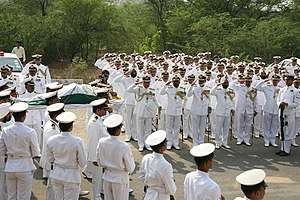
In the later years of his life, Nanda wrote his autobiography titled The Man Who Bombed Karachi: A Memoir.[62] The book provides an insider's account and the reminisces how India adapted an inventive strategy to defeat Pakistan, and the 32 years of his naval career.[63] Nanda participated in interviews on Indian War Heroes, a popular one being the interview by Sushil Sharma in 1997. His tactics in India's victory is still being discussed by channels on YouTube and Indian websites.
Admiral Nanda died in New Delhi on 11 May 2009 at the age of 93. He was survived by his wife Sumitra Nanda (died Feb 2011), son Suresh Nanda and grandchildren. His funeral was marked with full military honours at Brar Square Crematorium in New Delhi and was attended by top brass of Armed Forces.[64] The Telegraph however wrote that it was not as well attended as his naval career mandated.[1]
Dates of rank
| Insignia | Rank | Component | Date of rank |
|---|---|---|---|
 | Sub-lieutenant | Royal Indian Navy | 11 October 1941 (acting)[65] |
 | Lieutenant | Royal Indian Navy | 11 October 1942 (acting) 19 October 1946 (substantive)[9] |
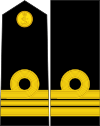 | Lieutenant Commander | Indian Navy | 1948 (acting) 30 June 1949 (substantive) |
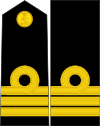 | Commander | Indian Navy | 30 June 1949 (acting) |
| Commander | Indian Navy | 26 January 1950 (recommissioning and change in insignia)[66] 31 December 1950 (substantive)[17] | |
| Captain | Indian Navy | 15 February 1954 (acting)[67] 31 December 1954[25] | |
| Commodore | Indian Navy | September 1956 (2nd class)[26] February 1962 (substantive)[68] | |
| Rear Admiral | Indian Navy | 14 May 1962 (acting)[34] 16 June 1964 (substantive)[36] | |
| Vice Admiral | Indian Navy | 1 March 1968[43] | |
| Admiral | Indian Navy | 1 March 1970[46] | |
See also
- Field Marshal Sam Manekshaw
- Air Chief Marshal Pratap Chandra Lal
Notes
Citations
- "Naval Obituaries: Admiral Sardarilal Nanda". The Telegraph. 16 June 2009. Retrieved 20 July 2011.
- "The man who bombed Karachi". Indian Express. Retrieved 7 February 2007.
- Nanda 2004, p. 18-20.
- "Karachi burned for seven days". Rediff. 18 January 2007.
- Nanda 2004, p. 27-31.
- Nanda 2004, p. 35-41.
- "Royal Indian Navy (Mutiny)". Hansard. 22 February 1946. Retrieved 7 June 2012.
- Nanda 2004, p. 54.
- Nanda 2004, p. 54-58.
- Nanda 2004, p. 61.
- Nanda 2004, p. 63-67.
- Singh 1986, p. 70-71.
- "PIB (Defence Wing)" (PDF). pibarchive.nic.in. 13 October 1948.
- "HMIS Delhi's Indian Ocean cruise" (PDF). pibarchive.nic.in. 27 April 1949.
- "H.M.I.S. DELHI RECEIVES GREAT WELCOME IN MAURITIUS" (PDF). pibarchive.nic.in. 30 May 1949.
- "Part I-Section 4: Ministry of Defence (Navy Branch)". The Gazette of India. 9 July 1949. p. 953.
- Nanda 2004, p. 75.
- "Part I-Section 4: Ministry of Defence (Navy Branch)". The Gazette of India. 13 January 1951. p. 8.
- "NEW COMMANDING OFFICERS FOR IN DESTROYER FLOTILLA" (PDF). pibarchive.nic.in. 12 November 1951.
- "CAPTAIN KATARI TO TAKE COMMAND OF DESTROYER FLOTILLA" (PDF). pibarchive.nic.in. 26 November 1951.
- Nanda 2004, p. 78-79.
- "IN DESTROYERS FOR ROYAL ESCORT" (PDF). pibarchive.nic.in. 18 December 1951.
- Nanda 2004, p. 78-81.
- "Part I-Section 4: Ministry of Defence (Navy Branch)". The Gazette of India. 15 January 1955. p. 15.
- "Part I-Section 4: Ministry of Defence (Navy Branch)". The Gazette of India. 27 April 1957. p. 107.
- Singh 1991, p. 80.
- "PRIM1 MINISTER TO VISIT FLAGSHIP INS MYSORE" (PDF). pibarchive.nic.in. 22 March 1958.
- Nanda 2004, p. 94-100.
- "Part I-Section 4: Ministry of Defence (Navy Branch)". The Gazette of India. 16 January 1960. p. 13.
- "Republic Day Awards" (PDF). pibarchive.nic.in. 25 January 1961.
- Nanda 2004, p. 106-109.
- Abidi & Sharma 2007, p. 25.
- "Part I-Section 4: Ministry of Defence (Navy Branch)". The Gazette of India. 15 June 1963. p. 207.
- "NEW DEPUTY CHIEF OF NAVAL STAFF" (PDF). pibarchive.nic.in. 14 May 1962.
- "Part I-Section 4: Ministry of Defence (Navy Branch)". The Gazette of India. 19 September 1964. p. 383.
- Nanda 2004, p. 139-144.
- "VISHISHT SEVA MEDAL CLASS I FOR NINE OFFICERS" (PDF). pibarchive.nic.in. 26 January 1966.
- "ADMIRAL NANDA TO COMMAND INDIAN FLEET" (PDF). pibarchive.nic.in. 24 May 1966.
- Nanda 2004, p. 150-151.
- "Reorganisation of Naval Commands" (2 March 1968). pibarchive.nic.in.
- "UPGRADATIONS IN DEFENCE SERVICES APPOINTMENTS" (PDF). pibarchive.nic.in. 1 March 1968.
- "Part I-Section 4: Ministry of Defence (Navy Branch)". The Gazette of India. 23 March 1968. p. 245.
- Nanda 2004, p. 156-160.
- "VICE-ADMIRAL NANDA NEXT CHIEF OF NAVAL STAFF" (PDF). pibarchive.nic.in. 15 November 1969.
- "Part I-Section 4: Ministry of Defence (Navy Branch)". The Gazette of India. 6 June 1970. p. 703.
- "Admiral Sardarilal Nanda". The Telegraph.
- "Indo-Pakistani War of 1971". Global Security. Archived from the original on 26 November 2016. Retrieved 27 November 2016.
- "Former Naval chief S M Nanda dies". The Times of India. 13 May 2009. Retrieved 22 November 2011.
- "Indian Navy's War Hero passes away: Cmde Babru Yadav led the Missile Boat Attack on Karachi in 1971". India Strategic. April 2010. Retrieved 21 July 2011.
- Singh 2005, pp. 210–211.
- Athale, Anil (12 December 2011). "Three Indian blunders in the 1971 war". Rediff. Archived from the original on 23 November 2016. Retrieved 27 November 2016.
- http://india.gov.in/myindia/padmavibhushan_awards_list1.php
- "Press Communique" (PDF). pibarchive.nic.in. 15 January 1972.
- "Part I-Section 4: Ministry of Defence (Navy Branch)" (PDF). The Gazette of India. 30 March 1974. p. 397.
- "ADMIRAL S.M. NANDA TAKES OVER AS SCI CHAIRMAN" (PDF). pibarchive.nic.in. 27 May 1974.
- Nanda 2004, p. 32-33.
- "'The man who bombed Karachi' dead". The Telegraph India. 13 May 2009. Retrieved 21 July 2011.
- "CBI closes Barak scandal case for lack of evidence". The Times of India.
- Correspondent, Legal (3 August 2012). "BMW hit-and-run: Court slaps Rs. 50 lakh fine on Nanda". The Hindu.
- "BMW case: Six lives would have been saved if Sanjeev Nanda showed mercy, says Supreme Court". NDTV.com.
- The Man Who Bombed Karachi: A Memoir. HarperCollins Publishers India. ISBN 9788172235628.
- "The Man Who Bombed Karachi: A Memoir | Hardcover". Amazon India.
- "Former Naval chief Admiral S M Nanda passes away". Times of India. 12 May 2009. Retrieved 21 July 2011.
- Nanda 2004, p. 31.
- "New Designs of Crests and Badges in the Services" (PDF). Press Information Bureau of India – Archive. Archived (PDF) from the original on 8 August 2017.
- Nanda 2004, p. 85.
- Abidi & Sharma 2007, p. 25.
References
- Nanda, S.M. (2004), The man who bombed Karachi, HarperCollins Publishers India, ISBN 978-8172235628
- Singh, Satyindra (1986), Under two ensigns: The Indian Navy, 1945-1950, Oxford & IBH Pub. Co, ISBN 978-8120400948
- Singh, Satyindra (1991), Blueprint to bluewater: The Indian Navy, 1951-65, Lancer International, ISBN 978-8170621485
- Abidi, S Sartaj Alam; Sharma, Satinder (2007), Services Chiefs of India, Northern Book Centre, ISBN 8172111622
| Military offices | ||
|---|---|---|
| Preceded by Adhar Kumar Chatterji |
Chief of the Naval Staff 1970–1973 |
Succeeded by Sourendra Nath Kohli |
| Preceded by Office created |
Flag Officer Commanding-in-Chief Western Naval Command 1968-1970 |
Succeeded by Nilakanta Krishnan |
| Preceded by R S David |
Flag Officer Bombay 1967-1968 |
Succeeded by Office abolished |
| Preceded by Benjamin Abraham Samson |
Flag Officer Commanding Indian Fleet 1966-1967 |
Succeeded by Sourendra Nath Kohli |
| Preceded by Adhar Kumar Chatterji |
Deputy Chief of the Naval Staff 1962-1964 |
Succeeded by Sourendra Nath Kohli |
| Preceded by First holder |
Commanding Officer INS Mysore 1956-1958 |
Succeeded by Sourendra Nath Kohli |
